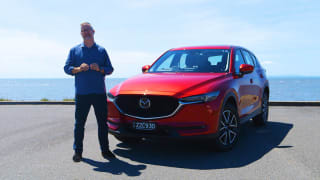
Mazda CX-5 2017 review
Mazda is currently enjoying a series of successes that's envied by almost every other car company in Australia, with a number of its models striking a real chord with Aussies.
Browse over 9,000 car reviews

Holden cars have come and gone over the past 10 years but one car has stood the test of a rapidly changing market.
When the Captiva first launched in 2006, Holden was selling over 50,000 Commodores annually, while Mitsubishi still made and sold the 380. The Captiva was hastily pressed into service as Holden was caught on the hop without a big SUV - the Commodore wagon-based Adventra failed to resonate while the Ford Territory took off.
The LTZ tops the three level Captiva range with seven seats, a choice of a diesel or petrol engine, and a host of largely cosmetic changes over the mid-spec LT.
| Holden Captiva 2017: 7 LTZ (awd) | |
|---|---|
| Safety rating | |
| Engine Type | 2.2L turbo |
| Fuel Type | Diesel |
| Fuel Efficiency | 8.1L/100km |
| Seating | 7 seats |
| Price from | $18,040 |
The LTZ can be had with a 3.0 V6 petrol auto, listing at $40,490, or the 2.2-litre diesel of our car for $41,490. At the time of writing (April 2017) the V6 was subject to a startlingly cheap $35,990 drive-away promotion that includes three years of scheduled services. Holden expects that price to continue for a few more months.
Standard on the LTZ are 19-inch wheels, 7.0-inch touchscreen, leather-look trim, body-coloured side mouldings, side steps, stainless steel scuff plates, electric driver's seat, LED daytime running lights, electric driver's seat, power windows and heated mirrors, reversing camera, front and rear parking sensors, dual-zone climate control, no-cost option electric sunroof, auto headlights, keyless entry and start, leather steering wheel, three 12 volt power outlets (front, back and boot) and a tyre inflation kit.
The 7.0-inch touchscreen is powered by Holden's 'MyLink' software and pushes sound out to eight speakers, two more than the LS and LT. You can connect via Bluetooth or with USB, and you can activate Apple CarPlay or Android Auto.

For MY16, General Motors' South Korean outpost started building Captivas with headlights that look more than ever like those from a VE Commodore, along with a more attractive version of the corporate twin grille treatment than that found on the Cruze.
With the LTZ's deep bumpers, chrome bits, silver detailing and body-coloured moulding, it almost looks contemporary, although the Miss Piggy dressing room LED daytime running lights look aftermarket.
Inside is a bit of a time warp, with the last major update coming a few years back, and including installation of the touchscreen. The dash is bitty and the column stalks are installed at a weird angle, the wiper pointing skyward on its fastest setting as though admonishing the heavens for its actions.
The side steps are a bit chintzy and are of no practical use unless getting mud/grit/rainwater all over the back of your legs is a requirement.
There is a ton of room in here. If you're paying by the cubic centimetre, you're doing quite well, and the LTZ comes standard with seven seats across three rows. The back row is a 50/50 split fold and provides adequate space for kids up to 150cm, and lankier folk for short trips won't be too upset, although they'll have to share the solitary cup holder. With all the seats in place, you've got an 87 litre boot which might squeeze in a golf bag.
The middle row doesn't slide but has a very clever flip-and-roll mechanism to provide easy access to the rear row. While the door aperture isn't huge, you can easily haul yourself in and plonk yourself in the back. The tiny centre armrest holds two cups and the doors will hold a can or small bottle. All three rows score a 12 volt power outlet.
Front seat passengers are treated to a pair of cup holders and a centre console bin under the armrest. The front seats are a bit plump and the lumbar support adjustment doesn't help. That aside, the driving position is suitably commanding for those who like that sort of thing.
The 2.4-litre diesel engine replaced the earlier 2.0-litre unit a few years ago and seems much better. Developing a handy 135kW/400Nm, it's a strong performer in the mid-range, comprehensively out-shining either petrol engine for torque and overall performance.
Power reaches the road through all four wheels via a six-speed transmission, but in practice it's mostly front-wheel drive until things get slippy. Sadly, there's no stop-start to reduce thirst.
All Captivas are rated to tow 750kg unbraked and 1500kg braked.
The ADR combined cycle figure came out at 8.5L/100km, while our real world week in the Captiva around the suburbs and in a bit of traffic yielded an indicated 12.9L/100km; rather higher than we expected. Our test car had plenty of kilometres under its belt, so it's certainly run in.
Like the rest of the range, the LTZ has six airbags, ABS, traction and stability controls, hill descent control, brake force distribution, active rollover protection, brake assist and three ISOFIX points, in addition to the reversing camera. The addition of front parking sensors is the only LTZ-exclusive safety item.
ANCAP awarded the Captiva five ANCAP stars, the highest rating available, in December 2011.
Basic Warranty
3 years / 100,000 km warranty
ANCAP Safety Rating

As with all new Holdens, the Captiva owner benefits from a three year/100,00km warranty and lifetime capped-price servicing.
Service visits are every nine months or 15,000km and until the fifth service are priced at $379. Once you get to that fifth visit, the price goes up to $439 until 120,000km when it jumps again to $960. After that, prices bounce around between $400 and $600 per service, with the occasional spike upwards. All prices are available on Holden's website.
The diesel's servicing is significantly more expensive than the V6 petrol.
Roadside assist is along for the ride for the first 12 months and you can extend or upgrade the coverage for an extra cost.
The LTZ's diesel engine combined with its on-demand style AWD is the best of the Captiva drivetrains. I can't imagine why you'd want the V6 petrol which is a long way behind on torque and not that much quicker to 100km/h, as though that would be a consideration.
The diesel is hardly the last word in refinement or features (there's no stop-start, for instance) and the six-speed automatic, while old, still holds its own. The power shuffling seems fairly smooth and given the amount of water we splashed through in it, that's a plus.
The oddly heavy steering feels like a hydraulic set-up, but once you get used to putting a bit of muscle into it, you'll be mildly surprised to find that the Captiva handles reasonably well, if not entirely convincingly. At the sorts of speeds owners will get up to, it's perfectly competent if unexpectedly firm. The 19-inch wheels do knock a bit of comfort off the ride (the balloons on the LS's 17-inch alloys soak up a lot more) but there's more grip available, no doubt helped along by the AWD system.
The back row occupants might not be as enthusiastic about the ride as the driver, however, and it's a bit uncomfortable back there across the bumps despite the independent rear suspension. It's also noisy throughout, with diesel thrum at speed and various road and wind noises depending on the surface.
It's an old car and you can't escape that. Step into a Honda CR-V, Mazda CX-9 or Hyundai Santa Fe and they feel much newer.
The best case to make for Captiva is its price, although the list price of the LTZ diesel doesn't make a lot of sense when you can pick up a Mazda CX-9 for not much more, and rivals from Hyundai and Kia for less. If you can twist your dealer's arm clean off and get a few grand knocked from the price, it's not a bad investment now most of the bugs are out of the system. But there's more to come from its rivals and, truth be told, the Captiva is not long for this world.
| Vehicle | Specs | Price* | |
|---|---|---|---|
| 5 LS (fwd) | 2.2L, Diesel, 6 SP AUTO | $14,630 – 19,250 | 2017 Holden Captiva 2017 5 LS (fwd) Pricing and Specs |
| 7 LT (awd) | 3.0L, ULP, 6 SP AUTO | $16,170 – 20,680 | 2017 Holden Captiva 2017 7 LT (awd) Pricing and Specs |
| 7 LS (fwd) | 2.2L, Diesel, 6 SP AUTO | $16,170 – 20,680 | 2017 Holden Captiva 2017 7 LS (fwd) Pricing and Specs |
| 7 LTZ (awd) | 3.0L, ULP, 6 SP AUTO | $17,600 – 22,330 | 2017 Holden Captiva 2017 7 LTZ (awd) Pricing and Specs |
| Price and features | 6 |
|---|---|
| Design | 6 |
| Practicality | 7 |
| Under the bonnet | 7 |
| Efficiency | 6 |
| Safety | 6 |
| Ownership | 7 |
| Driving | 6 |
$8,990
Lowest price, based on 169 car listings in the last 6 months